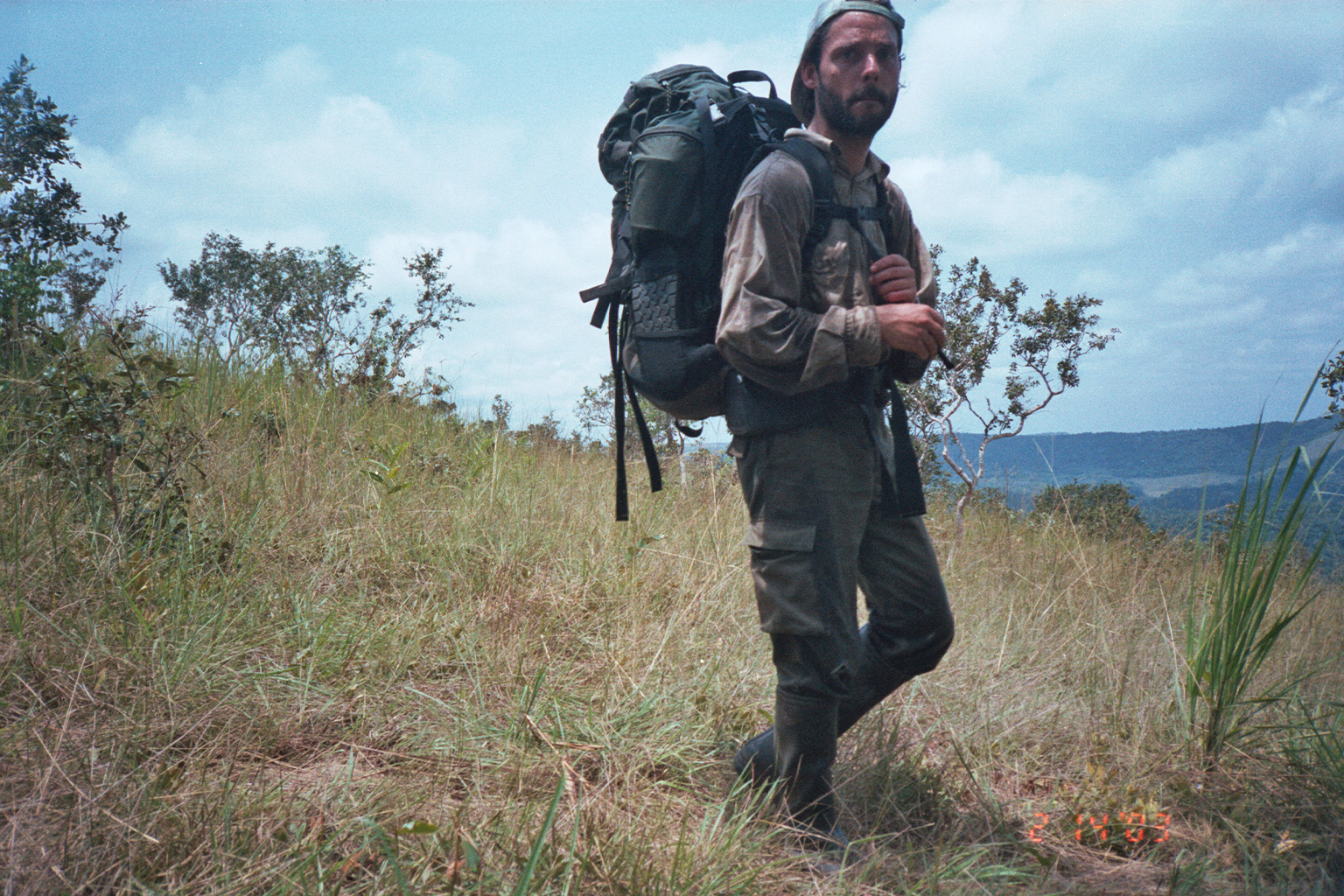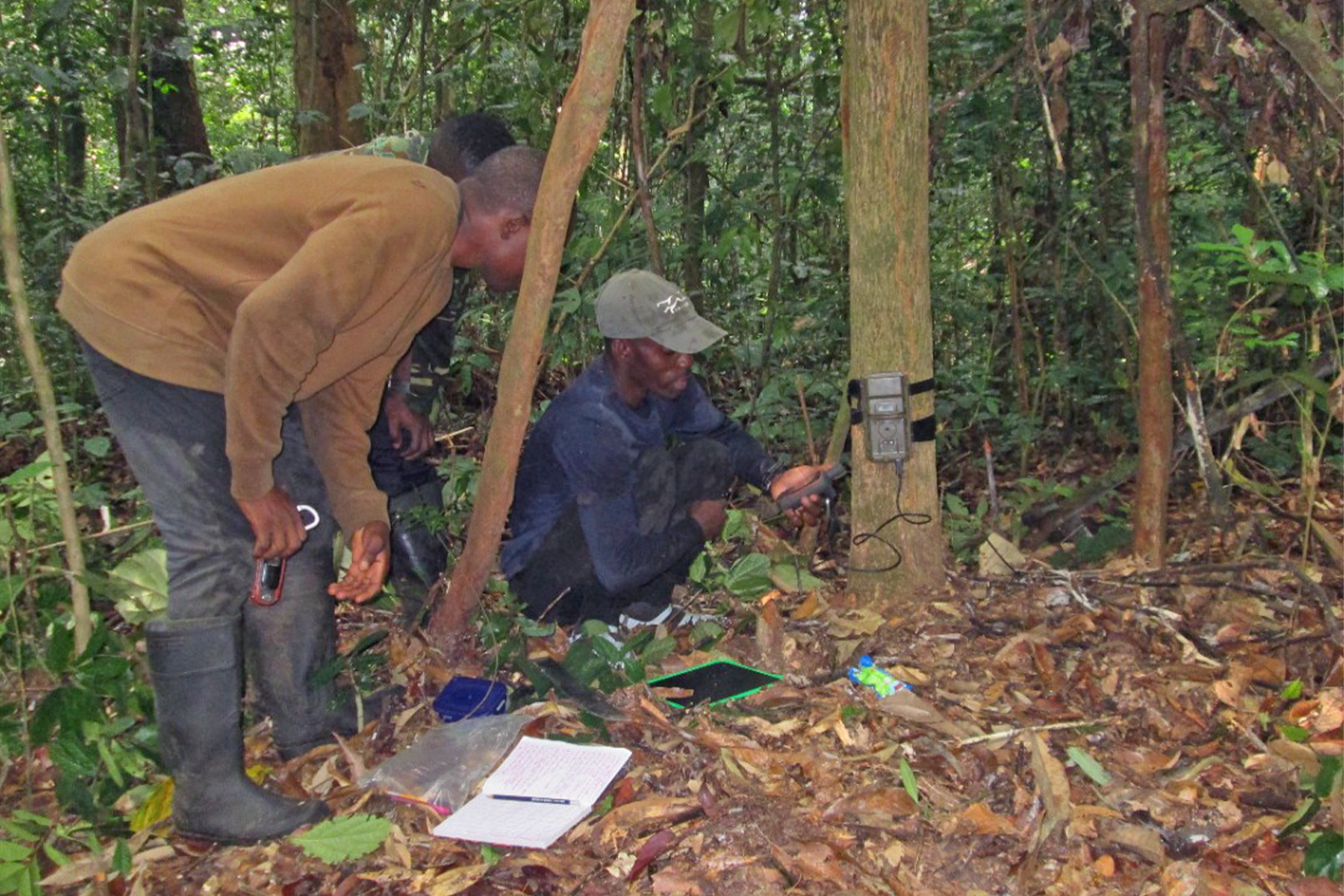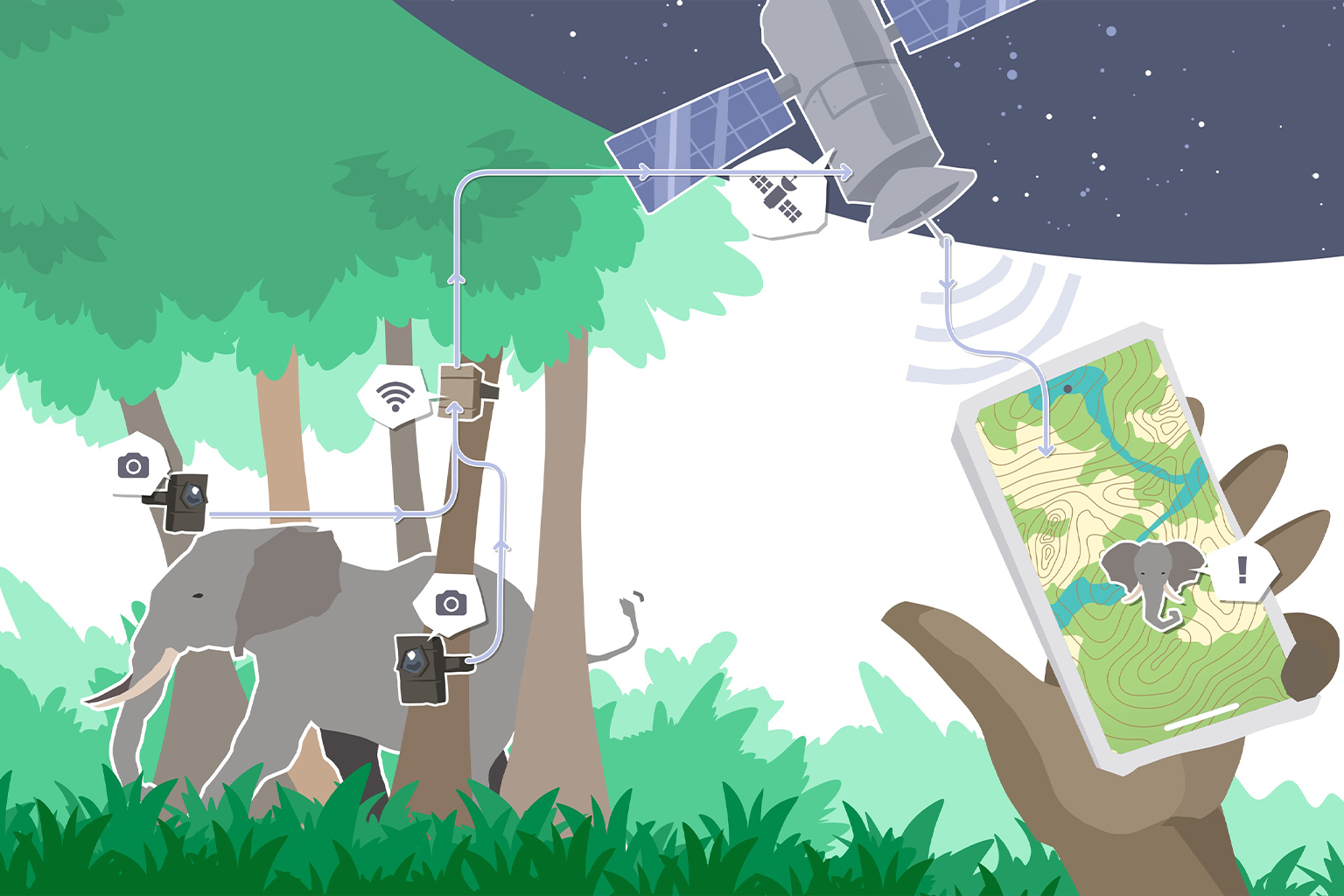Rich in forests and biodiversity, the Central African country of Gabon has long proved a fruitful testing ground for camera-trap technology.Snapshots of species once thought extinct in the country, such as lions, have helped inform conservation policy, including the establishment of national parks and protection of vast swaths of forest.The wealth of data generated means there are large data sets from various projects that researchers just don’t have the resources or time to sift through — which is why Gabon has also become a testing ground for artificial intelligence tools to aid in that task.Key limitations remain the cost of camera traps and the fact that many forms of data capture and analysis simply can’t be done by camera traps or AI, and still require human involvement.
Camera traps are helping researchers get a closer look at pockets of Gabon’s forests that were previously impractical to study. The Central African country has, at 80% by some estimates, the second-largest proportion of forest cover in the world, and only 2.2 million inhabitants. Many of its remote areas are hard to access — and even harder to monitor.
“Gabon in relation to the Congo Basin … first off, we’re a country that has never faced conflict,” said Brice Roxan Momboua of the National Agency of National Parks (ANPN). “The other strong point is that we have an 80% forest cover. There are zones where humans have never set foot. The majority is intact.”
Camera traps have been around for 130 years, but their usefulness in research has picked up sharply in the past two decades. Development of the technology has allowed researchers like Momboua, who leads biomonitoring projects using camera traps in Lopé National Park, to spot species they hadn’t previously seen in some of Gabon’s national parks, like honey badgers (Mellivora capensis) and aardvarks (Orycteropus afer).
For Momboua, camera traps are a huge improvement over alternative methods of studying Gabon’s biodiversity, like conducting transects — where researchers walk through a forest looking for traces of animal activity like dung, footprints, or nests. This can be grueling and time-consuming work. But a camera, once in place, can monitor a location deep in the forest for weeks or months and capture whatever passes in front of its sensors, including animals or behaviors that human presence would scare away.
In recent years, Gabon has become a fruitful testing ground for some of the latest innovations in camera-trap technology.
Early days of camera traps
Gabon’s history with camera traps goes back to at least the beginning of the 21st century. Philipp Henschel, working at the time with the Wildlife Conservation Society, says people thought he was a little weird when he showed up with five camera traps to study leopards in Lopé National Park in 2000. Henschel is now the regional director for West and Central Africa at Panthera, the big cat conservation NGO.
In those days, camera traps were awkward, frustratingly finicky tools for use in these tropical forests. Henschel would trek through the forests to find the perfect spot, then begin the intricate procedure of setting up the camera and flashes in a way that would get him as much coverage of an area as possible. These cameras shot on film and used an infrared tripwire as a trigger.
When things worked out, he got photos of leopards crossing in front of his cameras. When they didn’t work out, he’d come back to find a camera trap destroyed by termites or elephants.
Capture of two leopards in Lopé National Park, showing the camera trap array with a second 35 mm camera on the opposite side of the trail. Image courtesy of Philipp Henschel/WCS.
It was around this time that Henschel also became involved in the search for lions, which hadn’t been spotted for a while in Gabon. Camera traps were placed around the Batéké Plateau, a forest-savanna habitat in southeastern Gabon where researchers hoped to find traces of the big cat. Instead of lions, Henschel said, they captured images of poachers crossing over the border from the Republic of Congo.
Researchers concluded that lions were likely locally extinct in Gabon, thanks to poaching and destruction of habitat.
But in 2015, a student studying camera trap footage of chimpanzees caught sight of a leonine rear end. It marked the first time a lion had been recorded by science in Gabon since 1995.
By then, Henschel had joined Panthera. He returned to the area where the lion was spotted with 30 camera traps in his luggage to gather more documentation.
On his first night in Batéké, he said he heard a lion’s unmistakable calls. He found that the forest guards had been hearing it too, but with lions missing from this landscape for more than 15 years, they hadn’t recognized the sound.
Camera trap adoption today
Even though the earlier surveys did not find lions, Gabon’s government had designated parts of Batéké as protected areas. This formed part of a wider strategy to curb poaching and protect biodiversity, which saw Gabon set aside more than 10% of the country for national parks in 2005.
The government also backed conservation initiatives like reintroduction of species, biodiversity surveys and poaching prevention. In the decade that followed, many large mammal species returned to these areas. Researchers and national park officials have documented these recovering populations using camera traps.
Both the ANPN and Gabon’s water and forest ministry are working on developing protocols for camera trap use across Gabon’s national parks and logging concessions, Henschel told Mongabay.
“Other countries are exploring this as an option as well, but it’s not really written into the wildlife monitoring protocols like [it is] in Gabon,” Henschel said. “It’s really becoming an integral part of the government’s strategy to monitor and better protect wildlife.”
 Philipp Henschel testing a camera trap during a follow-up camera trap survey in Batéké Plateau National Park in 2003, the year after the park was established. Image courtesy of Philipp Henschel/WCS.
Philipp Henschel testing a camera trap during a follow-up camera trap survey in Batéké Plateau National Park in 2003, the year after the park was established. Image courtesy of Philipp Henschel/WCS.
To put camera traps into the field responsibly and effectively, researchers need more than just government mandates, though. They also need buy-in from local communities. Because while camera traps are installed to document wildlife, they also capture people walking by, and that can present privacy concerns.
Henschel said Panthera discusses camera trap placement with local communities to make sure they’re not encroaching on community land. Members of the community are also invited to accompany researchers to observe and advise on the positioning of camera traps. He said the conservation NGO has also prioritized training local people.
Other projects in the country have also sought to engage local communities.
“Local people sometimes ask us to install camera traps if there are attacks on domestic animals [chickens and goats] by felines [leopards],” Momboua told Mongabay.
Too much data, too little time
The proliferation of camera trap studies has at times come at a cost, though. Researchers end up with thousands — sometimes hundreds of thousands — of photos, which can take ages to sort through one by one.
Meredith S. Palmer, a postdoctoral scholar at Princeton University, calculated that to manually sort through one year of her camera trap footage would take her at least 1.3 years. And that’s if she worked non-stop with no holidays.
“So much camera trap data sits untouched on scientists’ hard drives that was gathered with great enthusiasm (and cost, and effort), but remains locked away because there was not a plan in place for extracting that information!” she told Mongabay in an email.
A growing number of tools, such as Wildlife Insights, hope to free up researchers’ time. When researchers upload their camera trap photos to Wildlife Insights, it eliminates “blanks” — images with no useful information due to poor lighting or false triggers from things like a leaf moving in the wind. For images with animals, Wildlife Insights’ AI offers suggestions about which animals appear in which photos.
 Camera traps being set up in the forests. Image courtesy of Brice Roxan Momboua.
Camera traps being set up in the forests. Image courtesy of Brice Roxan Momboua.
Researchers and technicians train the software to associate patterns with particular animals by showing it hundreds of thousands of images already cataloged by humans. The AI can rapidly scan millions of new images for familiar patterns and make an educated guess at which animals are pictured. Humans then review this guess to make the system better at sorting through these images.
Jonathan Palmer, executive director of conservation technology at WCS, is also a founding member of Wildlife Insights. He told Mongabay, “It will allow people to avoid some of the jobs that were kind of more laborious and it will allow people to actually start thinking about, well, what’s the next level of complexity? What’s the next question we want to answer?”
Online systems aren’t always practical, though.
“The existing AI solutions for camera trap data were just completely inaccessible to people working on the ground in National Parks in Gabon because they don’t have the internet bandwidth to upload huge image databases,” Robin Whytock, director of Digital Forest UK, told Mongabay in an email.
Whytock was part of a team at the ANPN that partnered with other agencies in Gabon to develop a tool that could be used offline: Mbaza AI. The software is installed on a laptop computer so that researchers can take it into the field with them and process their images on location. The data are then used to inform the state of biodiversity and conservation in protected areas.
The same technology that allows researchers to sort through thousands of images can also help in setting up real-time systems so researchers can get immediate notifications about elephant or poaching behavior.
Hack The Planet, a conservation tech company from the Netherlands, works with researchers like Momboua and Whytock to test a real-time detection system that seeks to reduce animal-human conflicts in Gabon. When the AI detects an elephant, it sends an alert via WhatsApp if the elephant appears in a photo near a residential area or farm.
They built the system by modifying off-the-shelf camera traps. This allows the camera trap to send images to a solar-powered mini-computer that sits in a weatherproof box in a nearby tree. If the computer detects an elephant in the image, it sends an alert with the coordinates and the probability of an elephant’s presence. Because this system uses satellite communication, it even works in remote areas with no phone signal.
 Illustration of the real-time elephant alert system. Image courtesy of Hack The Planet.
Illustration of the real-time elephant alert system. Image courtesy of Hack The Planet.
Hack The Planet is also working on adding an automated repelling system that blares randomized sounds and flashing lights to scare off elephants that approach the community’s plantations.
“We want to go back there and spend more time with this system to see if that’s actually possible,” said Hack The Planet co-founder Tim van Deursen. “Can we be more smart than the elephants and scare them away? And if that happens, that’s something that, probably, these villagers and these rangers will be very enthusiastic about.”
Momboua said systems like the ones developed by Hack The Planet and others are a timesaver, because the real-time alerts also include GPS locations. He adds, “We have information, the right information. And we can just go and verify in the field.”
The cost of technology
Though real-time alerts and the ability to sort through thousands of photos are game-changers for researchers, running camera trap studies often remains too expensive.
When Alice Laguardia, species monitoring specialist at WCS, set out to survey Gabon’s forest elephant (Loxodonta cyclotis) population, the first portion of her research was devoted to evaluating the best methodology. She and her team compared camera trapping with DNA sampling and transect distance sampling. They found that though camera traps helped them estimate population size more accurately, the system was too expensive to deploy at a nationwide scale. What’s more, identifying individual elephants from the footage was a challenge.
So the team ultimately settled for DNA analysis from dung samples they collected. Their research showed that Gabon had the largest population of this critically endangered species of elephant in the world, hosting around 95,000 individuals.
“Camera trapping seemed to give a good precision,” Laguardia said. “However, the cost to survey large areas seemed, in the example of the forest elephants, high.”
 An African forest elephant in Gabon. Image courtesy of WCS.
An African forest elephant in Gabon. Image courtesy of WCS.
Momboua has faced similar limitations. “We need funding,” he said. “When there is the possibility of getting financed [for camera traps], we’re game.”
A lot of the data gathered over the years is also scattered across multiple projects and organizations. Researchers are considering ways to bring that data together, but it’s difficult.
“I like things that bring people together … so it would be ideal if there were shared databases of elephant images where people could train their AI or whatever they need to use them for. But yes, I guess sharing images of elephants will always be a bit tricky,” Laguardia said, referring to the dangers of leaking information that poachers could use to track down elephants.
“We never associate the GPS position with the image itself because it does have issues for security,” she said.
And even with all the technological advances in the past few years, there are many forms of data capture and analysis that simply can’t be done by camera traps or camera trap AI.
“Very rarely in life do technologies replace [humans]. They normally augment or enhance existing approaches,” Jonathan Palmer of WCS said. “At the end of the day, technology rarely solves problems. It’s people who solve problems.”
In Gabon, a community’s plea against logging paves the way for a new reserve
Banner image: A red river hog in Loango National Park, Gabon. Image by Gregoire Dubois via Flickr (CC BY-NC-SA 2.0).
Citations:
Riggio, J., Jacobson, A., Dollar, L., Bauer, H., Becker, M., Dickman, A., … Pimm, S. (2012). The size of savannah Africa: A lion’s (Panthera leo) view. Biodiversity and Conservation, 22(1), 17-35. doi:1007/s10531-012-0381-4
Laguardia, A., Bourgeois, S., Strindberg, S., Gobush, K. S., Abitsi, G., Bikang Bi Ateme, H. G., … Stokes, E. J. (2021). Nationwide abundance and distribution of African forest elephants across Gabon using non-invasive SNP genotyping. Global Ecology and Conservation, 32, e01894. doi:1016/j.gecco.2021.e01894
Palmer, M. S., Huebner, S. E., Willi, M., Fortson, L., & Packer, C. (2021). Citizen science, computing, and conservation: How can “Crowd AI” change the way we tackle large-scale ecological challenges? Human Computation, 8(2), 54-75. doi:15346/hc.v8i2.123
Henschel, P., Coad, L., Burton, C., Chataigner, B., Dunn, A., MacDonald, D., … Hunter, L. T. (2014). New Records of a Threatened Lion (Panthera leo) Population in a West African National Park are Unconvincing. Plos One, 9(1):e83500. doi:10.1371/journal.pone.0083500
Whytock, R. C., Suijten, T., Van Deursen, T., Świeżewski, J., Mermiaghe, H., Madamba, N., … Abernethy, K. A. (2021). Real-time alerts from AI-enabled camera traps using the iridium satellite network: A case-study in Gabon, Central Africa. bioRxiv. doi:10.1101/2021.11.10.468078
FEEDBACK: Use this form to send a message to the author of this post. If you want to post a public comment, you can do that at the bottom of the page.
animal tracking, Animals, Artificial Intelligence, Biodiversity, Camera Trapping, cameras, Conservation, Conservation Technology, data, Endangered Species, Environment, Featured, Forests, Mammals, Protected Areas, Technology, Technology And Conservation, Tracking, Wildlife, Wildlife Conservation, Wildtech
Africa, Central Africa, Gabon, Sub-Saharan Africa
Source link : https://news.mongabay.com/2022/08/in-gabon-camera-trap-developers-find-the-ideal-proving-ground-for-their-craft/
Author :
Publish date : 2022-08-18 07:00:00
Copyright for syndicated content belongs to the linked Source.





